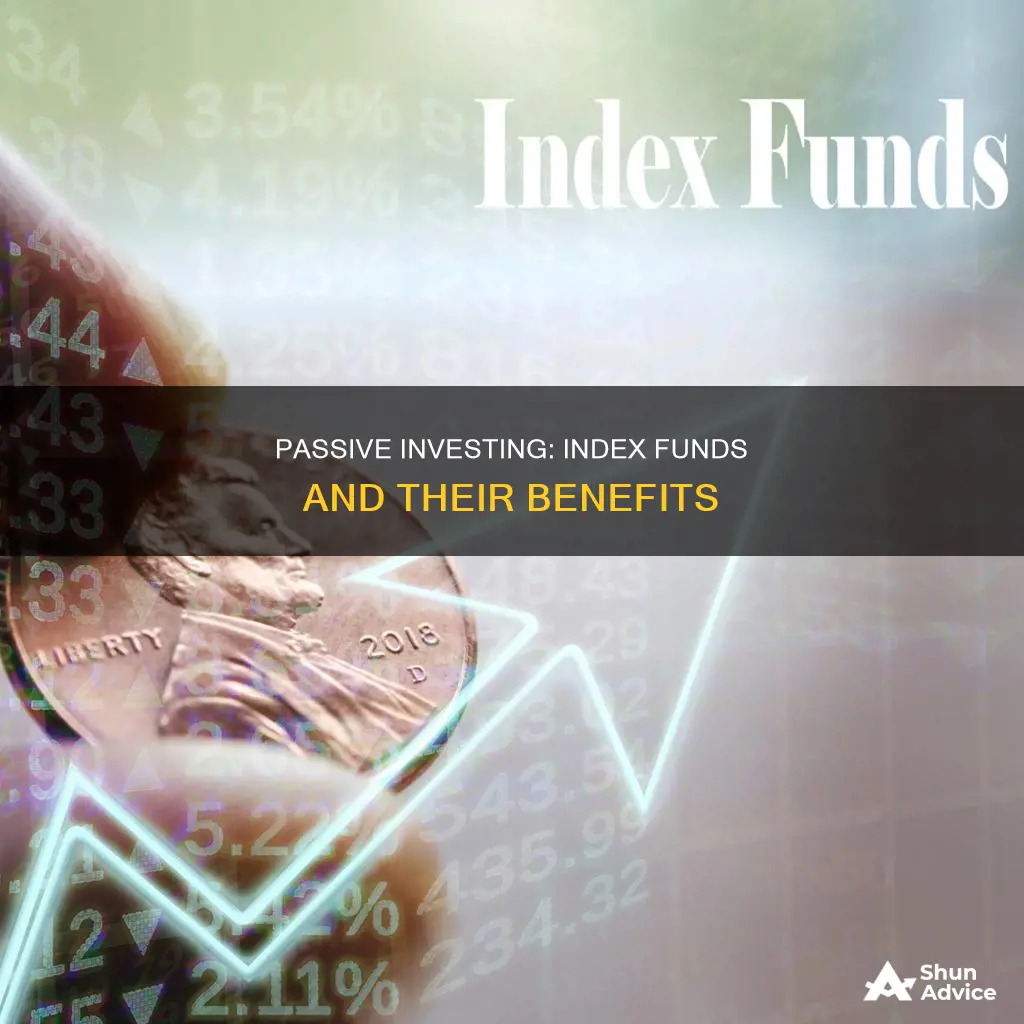
Index funds are a type of investment that aims to match the performance of a specific market index, like the S&P 500. They are a passive investment strategy, meaning they aim to cut the costs of deciding which securities to invest in by simplifying the portfolio construction process and reducing fees from frequent trading. Index funds are typically invested in through a mutual fund or exchange-traded fund (ETF) and can be purchased through a brokerage account, IRA, health savings account (HSA), or 401(k).
| Characteristics | Values |
|---|---|
| Type of investment | A passive, long-term investment strategy that aims to mirror the performance of a specific market index, like the S&P 500. |
| Investment options | Broad market funds, sector funds, domestic funds, international funds, and bond funds. |
| Investment accounts | Brokerage account, IRA, HSA, 401(k), UGMA/UTMA custodial account, Roth IRA, 529 plan, and taxable brokerage account. |
| Investment approach | DIY, active help from a financial professional, or robo-advisor. |
| Investment timing | Long-term investing is recommended, but it's possible to invest in index funds during a bear market. |
| Investment costs | Low fees, expense ratios, and tax-efficiency compared to actively managed funds. |
| Investment risks | Less volatile than individual stocks but still subject to market risk; no chance to beat the market. |
What You'll Learn

Understand the difference between passive and active investing
Understanding the difference between passive and active investing
Passive and active investing are two distinct investment strategies. The former is a long-term strategy that aims to mirror the performance of a market index by investing in a diverse range of securities. On the other hand, active investing involves frequent buying and selling of stocks with the goal of outperforming the market index.
Active Investing
Active investing is a short-term strategy that requires extensive research and analysis to identify the best investments to beat the market. It involves a hands-on approach, with investors making frequent buy-and-sell decisions based on information flow, market trends, shifts in the economy, and short-term price fluctuations. Active investing carries higher transaction and research costs and can lead to higher capital gains taxation. It also entails greater risk but offers the potential for higher returns.
Passive Investing
Passive investing, on the other hand, is a more balanced and cost-effective approach. It focuses on making long-term investments by buying a basket of assets that mirror the stock market index. Passive investors aim to match the market's performance rather than trying to outperform it. This strategy limits the buying and selling activities in response to changes in the tracked index, avoiding the temptation of short-term price movements. Passive investing is often associated with lower operating costs, lower risk, and lower capital gains taxes. However, it may not always provide above-market returns.
The choice between active and passive investing depends on your investment goals and risk tolerance. If you are investing for the long term, such as for retirement, passive investing may be more suitable due to its lower fees and less frequent trading. Active investing, on the other hand, may be preferable if you are willing to take on more risk and have the time and expertise to actively manage your portfolio.
Banks' CD Fund Investment Strategies: Where Does Your Money Go?
You may want to see also

Learn about the pros and cons of passive investing
Passive investing is a long-term strategy for building wealth by buying securities that mirror stock market indexes and holding them for the long term. It is a popular form of investing, with 71% of US investors surveyed in a 2021 Gallup poll saying that passive investing was a better strategy for long-term investors who want the best returns.
Pros of passive investing
- Lower maintenance: Passive investors don't need to constantly track the performance of their investments as they are in it for the long haul.
- Steady returns: Passive funds tend to outperform active funds over the long term.
- Lower fees: Passive investing doesn't require as much buying and selling, which can mean lower expense ratios.
- Lower capital gains taxes: Passive investors hold assets long-term, which means paying less in taxes.
- Lower risk: Passive investing can lower risk as you are investing in a broad mix of asset classes and industries, rather than relying on the performance of individual stocks.
Cons of passive investing
- Limited investment options: Passive investors can't handpick each investment or drop companies they don't think are worthwhile because they don't own the underlying stocks directly.
- May not get above-market returns: Because the goal is to match the market average, you may not achieve above-market returns.
- Lack of flexibility: Passive funds are limited to a specific index or predetermined set of investments and are not able to pivot when the market shifts.
- Market risk: Passive funds are subject to market risk and will decline in value when the market does.
Mutual Fund Investors: Declare Investments in Your ITR
You may want to see also

Explore different types of index funds
Index funds are a popular investment choice due to their simplicity, low cost, and diversification benefits. They are a type of mutual or exchange-traded fund (ETF) that tracks the performance of a market index, such as the S&P 500, by holding the same stocks or bonds or a representative sample. Here are some of the different types of index funds:
- Broad Market Index Funds: These funds aim to capture a large portion of the investable market, such as the total stock market or a specific country or region. They provide low-cost exposure to an entire asset class. Examples include the Vanguard Total Stock Market ETF and the Schwab U.S. Broad Market ETF.
- Market Cap Index Funds: These funds invest based on specific market capitalizations. Large-cap funds, like those tracking the S&P 500, hold companies with market caps above $10 billion, while small-cap funds focus on companies with market caps below $2 billion. Examples include the Fidelity 500 Index Fund and the iShares Russell 2000 ETF.
- Equal Weight Index Funds: Unlike traditional index funds that weight holdings by market capitalization, equal weight index funds give each holding in the fund an equal percentage of fund assets. This approach avoids the risk of a single company dominating the fund's portfolio. Examples include the Invesco S&P 500 Equal Weight ETF and the Direxion Nasdaq-100 Equal Weighted Index Shares.
- Fixed Income/Debt Index Funds: These funds track bond indices in the same way that stock funds track stock market indices, allowing for low expense ratios. They can play an important role in an investor's portfolio, especially during retirement. Examples include the Vanguard Long-Term Bond ETF and the iShares 1-5 Year Investment Grade Corporate Bond ETF.
- Sector-Based Index Funds: These funds are great for investors who have specific views on certain areas of the economy. They allow investors to express an investment opinion without the need to research individual securities. Examples include the Consumer Discretionary Select Sector SPDR Fund, which focuses on consumer discretionary companies, and the Vanguard Communication Services Index Fund, which invests in companies providing communication services.
- International Index Funds: These funds provide an easy way to gain exposure to geographic areas outside the U.S. They offer a diversified portfolio of companies from a specific country or region. Examples include the Vanguard FTSE Emerging Markets ETF, which invests in countries like China and Brazil, and the iShares Core MSCI Total International Stock ETF, which invests in both developed and emerging international markets.
- Socially Responsible Index Funds: These funds have gained popularity as investors increasingly care about how their money is invested. They may include companies with a focus on environmental, social, and governance (ESG) issues or exclude companies involved in certain business activities, such as the sale of firearms, alcohol, or tobacco. Examples include the Vanguard ESG U.S. Stock ETF, which screens for specific ESG criteria, and the iShares Global Clean Energy ETF, which focuses on companies in the clean energy sector.
By understanding the different types of index funds available, investors can make informed decisions about which funds align with their investment goals, risk tolerance, and diversification strategies.
Where Fund Managers Put Their Own Money
You may want to see also

Decide how hands-on you want to be with your investments
When it comes to investing in passively managed index funds, you have the option to choose between a more hands-on or hands-off approach. Here are some things to consider when deciding how involved you want to be in managing your investments:
Understanding Passive Investing
Passive investing is a long-term strategy where you buy securities that mirror stock market indexes and hold them for an extended period. This approach can lower risk because you're investing in a diverse mix of asset classes and industries, rather than individual stocks. It's a popular strategy, as it allows you to replicate the returns of a particular market index. This means you don't need to actively pick securities or time the market.
Hands-on Approach: Self-directed Research
If you choose to take a more hands-on approach, you'll need to educate yourself on the principles of index fund investing. This includes staying informed about market trends, tax implications, and regularly reviewing and adjusting your portfolio. You'll be responsible for making investment decisions, such as selecting an online brokerage platform, opening and funding an account, choosing an index fund, and monitoring your investments over time. This approach may suit you if you're willing to put in the time and effort to research and make your own investment decisions.
Hands-off Approach: Seeking Professional Advice
On the other hand, if you prefer a more hands-off approach, you can seek guidance from a financial advisor. A financial advisor can help you select an index fund that aligns with your financial goals and risk tolerance. They can provide advice on diversifying your portfolio by investing in multiple index funds that track different markets. This approach can be beneficial if you don't have the time or expertise to manage your investments actively. It's also useful if your finances are complex and you need help navigating tax implications.
Combining Passive and Active Strategies
It's worth noting that you can also combine passive and active investment strategies. You can invest in passive index funds while actively managing your portfolio through diversification and periodic rebalancing. This involves deciding how to allocate your investments across different asset classes and sectors and periodically adjusting your portfolio to maintain your desired allocation.
Key Considerations
When deciding how hands-on you want to be, consider your financial goals, the time and resources you're willing to invest in managing your portfolio, and your risk tolerance. Additionally, keep in mind that passive investing is generally a long-term strategy, and short-term returns may vary.
Unlocking Dimensional Fund Advisors: A Guide to Smart Investing
You may want to see also

Compare fees and costs of different funds
When comparing fees and costs across different passively managed index funds, it's important to consider various factors, including expense ratios, management fees, transaction costs, and potential commissions. Here's a detailed guide to help you navigate these aspects:
Expense Ratios:
Passively managed index funds typically have lower expense ratios compared to actively managed funds. The expense ratio represents the percentage of assets under management used to cover fees such as management fees, expenses, and, in some cases, 12b-1 fees. Passively managed funds generally have lower costs because they don't require extensive research and active trading strategies. According to sources, the average expense ratio for passively managed funds can be as low as 0.04%, while actively managed funds often charge 0.44% or higher.
Management Fees:
Management fees are a component of the expense ratio and are paid to those who manage and trade the fund's portfolio. Since passively managed funds require less active management, these fees tend to be lower compared to actively managed funds. The average management fee for passively managed funds is approximately 1.10%.
Transaction Costs:
Passively managed funds generally incur lower transaction costs because they trade less frequently. Reduced trading means fewer commissions and lower operational expenses. This can result in significant cost savings over time.
Commissions:
When investing in passively managed index funds, you may encounter commissions, especially when buying and selling exchange-traded funds (ETFs). ETFs are often traded like stocks, and some brokers may charge commissions for these transactions. However, it's worth noting that there are also commission-free ETFs available in the market.
In summary, passively managed index funds generally offer lower fees and costs compared to their actively managed counterparts. This is primarily due to their passive investment strategy, which involves mirroring market indexes rather than actively picking securities. By minimising active trading and research, passively managed funds can provide a more cost-effective option for long-term investors.
Bank Loan Funds: A Smart Investment Choice
You may want to see also
Frequently asked questions
Passively managed index funds are a type of investment that aims to match the performance of a specific market index, like the S&P 500. They hold all or a representative sample of the securities in that index, allowing investors to gain exposure to a broad range of stocks or bonds through a single fund, often at a lower cost.
There are several benefits to investing in passively managed index funds, including:
- Lower fees: Passive funds tend to have lower expense ratios than actively managed funds since they require less research and trading.
- Transparency: The holdings of an index fund are typically well-known and easily accessible.
- Tax efficiency: Passive funds that employ a buy-and-hold strategy tend to generate lower taxable capital gains.
- Simplicity: Index funds are easier to implement and understand than dynamic strategies that require constant research and adjustment.
Here are the general steps to start investing in passively managed index funds:
- Decide on your investment goals and choose an account type that aligns with those goals (e.g., retirement account, education savings, health savings, etc.).
- Select an investment platform or brokerage that offers diverse investment options, low fees, and easy access.
- Determine your risk tolerance and investment objectives to choose the right index funds for your portfolio (e.g., broad market funds, sector funds, domestic funds, international funds, bond funds, etc.).
- Decide on your level of involvement (DIY, active help from a financial professional, or passive management through a robo-advisor).
- Calculate the amount you can comfortably invest based on your financial situation and the investment minimums of the chosen funds.
- Research and select specific index funds to invest in, considering factors such as performance history, management fees, and the indexes they track.
- Purchase shares of the chosen index funds through your brokerage or directly from the fund provider.
Some potential drawbacks of investing in passively managed index funds include:
- Lack of flexibility: Passive funds are limited to a specific index or set of investments and may not be able to pivot during market shifts.
- Smaller potential returns: Passive funds typically aim to match the market or their benchmark index rather than aiming for outperformance.
- Market risk: Passive funds are subject to market volatility and can experience declines when the overall market declines.







